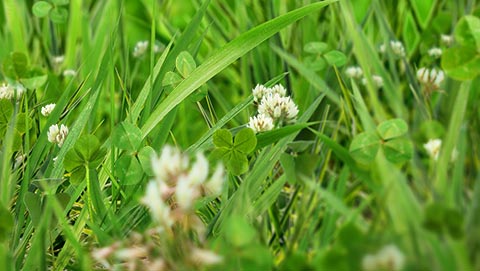Nitrogen plays an important role in New Zealand agriculture
Nitrogen fertiliser is used to increase the yield of pasture and crops, helping to fill the feed gaps that invariably arise during the year. When used appropriately, it is an effective addition to the nitrogen provided naturally by clovers and other legumes.
Nitrogen and plants
Nitrogen is needed to build proteins, DNA and enzymes in plants and animals. It has a major effect on plant quality. Nitrogen is also an essential component of chlorophyll, the green pigment in plant leaves that converts sunlight into energy. Therefore, plants with an adequate supply of nitrogen show strong, vigorous, dark green growth.
In crops and pasture, nitrogen supply drives yield in the absence of any other growth constraint.
Nitrogen loss
Nitrogen can be lost from the soil-plant system through three major pathways: dentrification, leaching and volatilisation.
Denitrification is caused by specific bacteria reducing nitrate to two gases (nitrogen gas and nitrous oxide gas), which then escape to the atmosphere.
Leaching is the loss of nitrate as it is carried down through the soil in water and into receiving water bodies. It can be a major source of nitrogen loss, particularly on sandy soils in areas that receive high rainfall.
Volatilisation is the loss of nitrogen to air as ammonia gas. It occurs in soils when there are high concentrations of ammonia, e.g. in urine patches and when urea fertiliser is used. The rate of volatilisation increases mostly under dry soil condition, but also under windy conditions and high soil temperatures. The risk of ammonia loss also rises with increasing use of urea
Implications of nitrogen loss
Losses occur regardless of whether or not nitrogen fertiliser is applied; they are a natural function of fertile soil. However, inappropriate use of nitrogen fertiliser can exacerbate these losses.
Find out more about managing nitogen loss
Signs of deficiency
Nitrogen affects both the quantity and quality of plants. Nitrogen-deficient plants cannot produce enough chlorophyll. Therefore, the first signs of a deficiency show as yellowing of older leaves, because the plant moves nitrogen reserves from old tissues to new growth.
Plants lacking in nitrogen are typically stunted and lack vigour because they cannot capture enough energy from sunlight to support their growth. As they also contain less protein, they have less value as a food source for humans (e.g. cereal crops) and animals (e.g. pasture).
Nitrogen inputs
Nitrogen fixation by legumes
One way to add nitrogen to the farming system is to include legumes, such as clover, in the pasture. This is an important part of the New Zealand farming landscape. Legumes are able to associate with bacteria that capture (fix) nitrogen in the air and turn it into a form that can be used by plants. In return, the plant provides bacteria with carbohydrates they need for growth. Clovers make a big contribution, but they also demand higher soil fertility in order to grow well. New Zealand’s climate is extremely favourable for the growth of clovers.
Nitrogen fertilisers
Nitrogen fertilisers help increase the productivity of the land. They are used almost universally on farms and orchards, and can be applied as:
- Urea – the most commonly used and a highly concentrated source of nitrogen (46% N)
- Nitrate – e.g. potassium nitrate, sodium nitrate, ammonium nitrate
- Ammonium (in solid or liquid forms) – e.g. sulphate of ammonia, ammonium nitrate, anydrous ammonia, hydrous ammonia
- Organic sources - composts, blood and bone, industrial waste
Once in soil, urea and ammonium both get converted to nitrate by the actions of soil bacteria. Plants can take up urea, ammonium and nitrate.
Download and read the full fact sheet
To maintain clover nitrogen fixation and ensure best pasture response and the most profitable outcomes, apply these principles:
- Do not apply to waterlogged soils or when heavy rain is due. However, if using urea, 5-10 mm rain within 8 hours of application is required to minimise volatilisation loss
- On dairy farms, apply nitrogen after cows have grazed the paddock
- On sheep and beef farms, use nitrogen strategically to boost pasture growth and grow feed for specific purposes, e.g. feeding lambs
- Nitrogen applied at set times of crop growth boosts yields – soil tests can be done to determine how much nitrogen fertiliser is needed (if any)

Understanding Nitrogen on your farm
Nitrogen plays an important role in New Zealand agriculture. When used appropriately, it is an effective addition to the nitrogen provided naturally by clovers and other legumes.
To help you understand nitrogen use on your farm we have collated a range of nitrogen advice backed by science.